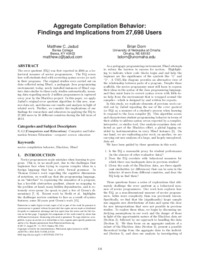Aggregate Compilation BehaviorFindings and Implications from 27, 698 Users
Publikationsdatum:
Zu finden in: ICER 2015 (Seite 131 bis 139), 2015
|
 |
 Diese Seite wurde seit 1 Jahr inhaltlich nicht mehr aktualisiert.
Unter Umständen ist sie nicht mehr aktuell.
Diese Seite wurde seit 1 Jahr inhaltlich nicht mehr aktualisiert.
Unter Umständen ist sie nicht mehr aktuell.
 Zusammenfassungen
Zusammenfassungen
The error quotient (EQ) was first reported in 2006 as a behavioral measure of novice programmers. The EQ scores how well students deal with correcting syntax errors (or not) in their programs. The original studies were carried out on data collected using BlueJ, a pedagogic Java programming environment; today, newly installed instances of BlueJ capture data similar to these early studies automatically, meaning data regarding nearly 2 million programmers is captured every year by the Blackbox project. In this paper, we apply Jadud's original error quotient algorithm to this new, massive data set, and discuss our results and analysis in light of related work. Further, we consider the implications of our findings for researchers and educators in applying the EQ to 27,698 users in 10 different countries during the fall term of 2013.
 Dieses Konferenz-Paper erwähnt ...
Dieses Konferenz-Paper erwähnt ...
 Zitationsgraph
Zitationsgraph
 Zitationsgraph (Beta-Test mit vis.js)
Zitationsgraph (Beta-Test mit vis.js)
 3 Erwähnungen
3 Erwähnungen 
- ICER 2016 - Proceedings of the 2016 ACM Conference on International Computing Education Research, ICER 2016, Melbourne, VIC, Australia, September 8-12, 2016 (Judy Sheard, Josh Tenenberg, Donald Chinn, Brian Dorn) (2016)
- With a Little Help From My Friends - An Empirical Study of the Interplay of Students' Social Activities, Programming Activities, and Course Success (Adam S. Carter, Christopher D. Hundhausen) (2016)


- With a Little Help From My Friends - An Empirical Study of the Interplay of Students' Social Activities, Programming Activities, and Course Success (Adam S. Carter, Christopher D. Hundhausen) (2016)
- Programming in K–6 - Understanding Errors and Supporting Autonomous Learning (Jacqueline Staub) (2021)


- DELFI 2024 (Sandra Schulz, Natalie Kiesler) (2024)


- Correlation of Error Metrics in Python CS1 Courses (Annabell Brocker, Ulrik Schroeder) (2024)


- Correlation of Error Metrics in Python CS1 Courses (Annabell Brocker, Ulrik Schroeder) (2024)
 Anderswo finden
Anderswo finden
 Volltext dieses Dokuments
Volltext dieses Dokuments
 |  Aggregate Compilation Behavior: Fulltext at the ACM Digital Library ( Aggregate Compilation Behavior: Fulltext at the ACM Digital Library ( : :  , 834 kByte; , 834 kByte;  : :  2020-11-28) 2020-11-28) |
 Anderswo suchen
Anderswo suchen 
 Beat und dieses Konferenz-Paper
Beat und dieses Konferenz-Paper
Beat hat Dieses Konferenz-Paper während seiner Zeit am Institut für Medien und Schule (IMS) ins Biblionetz aufgenommen. Beat besitzt kein physisches, aber ein digitales Exemplar. Eine digitale Version ist auf dem Internet verfügbar (s.o.). Aufgrund der wenigen Einträge im Biblionetz scheint er es nicht wirklich gelesen zu haben. Es gibt bisher auch nur wenige Objekte im Biblionetz, die dieses Werk zitieren.











 Biblionetz-History
Biblionetz-History